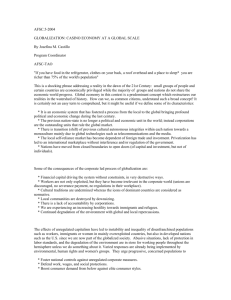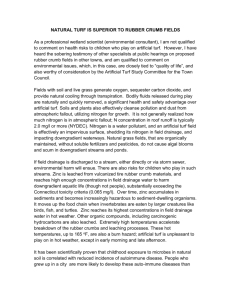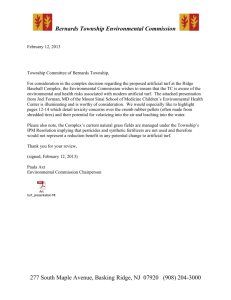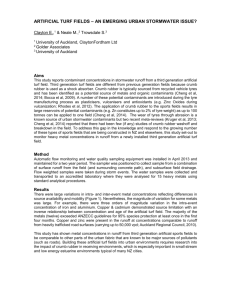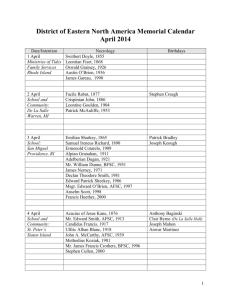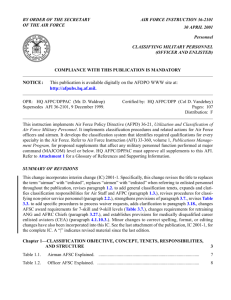Memorandum - Town of Swampscott
advertisement
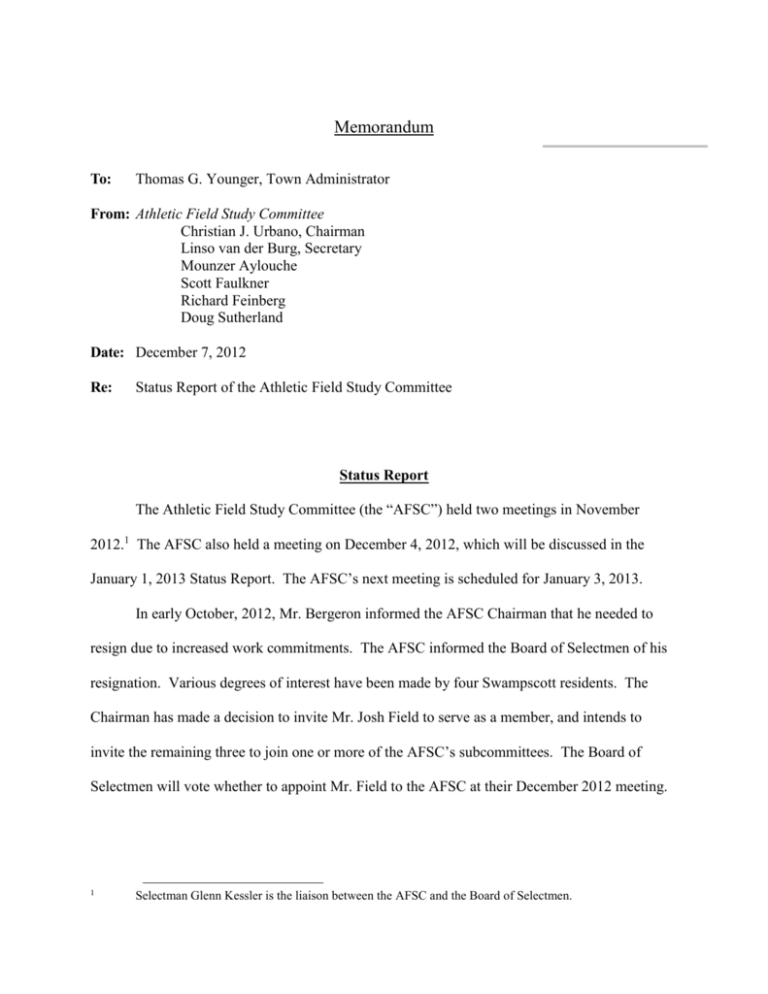
Memorandum To: Thomas G. Younger, Town Administrator From: Athletic Field Study Committee Christian J. Urbano, Chairman Linso van der Burg, Secretary Mounzer Aylouche Scott Faulkner Richard Feinberg Doug Sutherland Date: December 7, 2012 Re: Status Report of the Athletic Field Study Committee Status Report The Athletic Field Study Committee (the “AFSC”) held two meetings in November 2012.1 The AFSC also held a meeting on December 4, 2012, which will be discussed in the January 1, 2013 Status Report. The AFSC’s next meeting is scheduled for January 3, 2013. In early October, 2012, Mr. Bergeron informed the AFSC Chairman that he needed to resign due to increased work commitments. The AFSC informed the Board of Selectmen of his resignation. Various degrees of interest have been made by four Swampscott residents. The Chairman has made a decision to invite Mr. Josh Field to serve as a member, and intends to invite the remaining three to join one or more of the AFSC’s subcommittees. The Board of Selectmen will vote whether to appoint Mr. Field to the AFSC at their December 2012 meeting. 1 Selectman Glenn Kessler is the liaison between the AFSC and the Board of Selectmen. November 8, 2012 Meeting Carpell Sports Surfaces Corp. Presentation At our November 8, 2012 meeting, Mr. Bill Lorenz, the track and turf business development representative of Carpell Sports Surfaces Corp. (“Carpell”), headquartered in Concord, New Hampshire, gave a presentation to the AFSC. Mr. Lorenz discussed the services Carpell delivers, including the sale and installation of artificial turf fields and variations of infill that might be used. Mr. Lorenz also explained that Carpell offers FIFA2 certification for certain of its field installations, noted that thermoplastic elastomers (or “TPE”) is up to 30 degrees cooler on summer days than the commonly used “crumb rubber” made from recycled tires,3 but is approximately 25% more expensive. Mr. Lorenz also noted: Generally, there is an 8 year warranty on artificial turf fields, which is the industry standard; TPE fields also require a shock pad, which accounts for some of the increased cost; Most purchasers of artificial turf fields use the oval, C6 grade resin, monofilament artificial grass (C4 being too loose, C8 being too stiff); and All of their products and workmanship are warranted and bonded. Mr. Lorenz concluded that his company would likely bid to sell and install the artificial turf field and looks forward to working with the Town of Swampscott if successful. He also indicated that 2 FIFA is the governing body for, among other things, international soccer. FIFA has extremely stringent guidelines respecting artificial turf fields. 3 Please refer to our prior Status Reports regarding the debate over whether crumb rubber infill is a significant or material health risk. While the AFSC has not formally voted on the matter, the AFSC is leaning away from recommending crumb rubber and towards TPE infill, notwithstanding the additional cost. TPE is manufactured specifically for use as artificial turf infill but without any of the potential hazardous chemicals found in crumb rubber. 2 Carpell may be able to provide a discount on TPE, assuming there are no legal restrictions against doing so, since Swampscott might be the first town in New England to use such infill. Selectman Barry Greenfield’s Proposal Selectmen Barry Greenfield gave a presentation of his plan to address the town’s athletic field conditions. Mr. Greenfield first noted that the AFSC should follow the lead of the recent School Building Committee’s actions in informing the public of the need for the feasibility study. As a result of their efforts, Town Meeting voted in favor of the request almost unanimously. The SBC’s actions included (a) community involvement; (b) emails and phone calls to Town Meeting members, press releases, and forums to discuss the parameters of the feasibility study and what exactly a vote in favor of the study meant. Mr. Greenfield next presented his vision for athletic fields in Swampscott, including: Phase 1 – installing an artificial turf field at Upper Jackson; Phase 2 – relocating the JV baseball field to the middle school “bowl;” Phase 3 – enlarging the current Blocksidge Field and placing another natural grass field at the current field hockey and JV baseball field locations, thus creating 5 playing fields at Phillips Park and the artificial turf field at Upper Jackson. During open discussion of the proposal, the Committee members, Mr. Lorenz, and Mr. Greenfield discussed whether the middle school’s bowl was large enough for a JV baseball field (the homerun “fence” may be too short), whether Upper Jackson was wide enough to accommodate an MIAA regulation soccer field and, if so, whether it could be installed without damaging the track, and whether the JV baseball field could be relocated at the rear of Phillips Park. It was noted that the cost figures for the proposal were somewhat broad estimates and will need to be narrowed. The AFSC appreciates all of the hard work Mr. Greenfield put into his 3 presentation and, even if not adopted, hopes to use some of his concepts toward whatever proposal is ultimately recommended. November 13, 2012 Board of Health Meeting The Swampscott Board of Health invited liaison Glenn Kessler and the AFSC to their November 13, 2012 meeting to discuss the potential health risks associated with artificial turf fields. The principal concern of the Board of Health was the use of “crumb rubber” infill. The Board of Health adamantly opposed the All-for-One Field Committee’s proposed use of crumb rubber for an artificial turf field at the May 2012 Town Meeting and indicated that nothing had changed their position since then. Chairman Urbano and Mr. Feinberg also attended the meeting. Mr. Urbano directed the Board of Health’s attention to the numerous federal, state and local environmental agencies that have each determined that there is no public health concern identified, either from inhalation of volatile organic chemicals or semi-volatile organic chemicals, or from skin infections (primarily antibiotic resistant staff infections), with the use of crumb rubber for artificial turf infill. Although the reports identified trace amounts of these chemicals in the air at ground level or in the breathing zone, the reports found that cancer risks were well within typical risk levels in the community from ambient pollution sources and were below target risks associated with many air toxics regulatory programs. Moreover, neither acute nor chronic non-cancer risks were elevated above acceptable hazard indices. See, e.g., Human Health Risk Assessment of Artificial Turf Fields Based upon Results from Five Fields in Connecticut (CT Dept. of Pub. Health, July 28, 2010); Health Issues with Artificial Turf Fields, (CA Dept. of Resources, Recycling and Recovery, Oct. 2010); but see Alderman, Nancy 4 Artificial Turf: Exposures to Ground-Up Rubber Tires: Athletic Fields, Playgrounds, Gardening Mulch (Environmental & Human Health, Inc. 2007). Nonetheless, the Board of Health stated that they could point to numerous health studies to the contrary, and Mr. Kessler also cited specific examples of studies concerned about the potential health risks with inhalation of crumb rubber dust. Mr. Kessler and Mr. Urbano also noted that crumb rubber becomes extremely hot in the summer months. Some studies have measured the temperature of crumb rubber to exceed 145 ºF. They also noted that TPE and organic infill are much cooler. According to Mr. Lorenz of Carpell, TPE can be 30ºF cooler. In any event, simply forbidding children to play on a field when the surface temperature exceeds a set degree is not difficult and easily monitored with inexpensive infrared equipment. Mr. Urbano told the Board of Health that the AFSC appreciated that the cited reports finding that crumb rubber was not a health risk were met with a large number of opposing views. Further, Mr. Urbano stated that the issue was all but moot, as there was likely a large majority of members who will vote to use TPE rather than crumb rubber. The Board of Health was pleased to hear this, but reserved the right to review any potential health concerns identified with TPE. The Board of Health also directed the AFSC to GeoTurf, a company that uses organic products like coconut husk and cork infill for its artificial turf fields. The AFSC is investigating these products. November 20, 2012 Meeting After the November 8, 2012 meeting, the AFSC sought to conduct an informal survey of Swampscott residents to gauge their feelings about the conditions of the current athletic fields in Swampscott, whether they would be interested in a new field, lights, and/or grandstands, and 5 how such facilities should be funded. In order to conform to the Open Meeting Law, formal notice of a meeting was posted. At the meeting, the AFSC finalized a short survey to be provided to residents attending the Thanksgiving Day high school football game. On Thanksgiving Day, November 22, 2012, Messrs. van der Burg, Feinberg, and Urbano set up a small table at Blocksidge Field and conducted the survey, a copy of which is attached to this report as Exhibit A. In summary, 96% of the sixty-seven (67) people who completed the survey would like to see a new athletic field installed in town, 82% would like that field to be located at Blocksidge Field, 72% would like that field to be made from artificial turf, 81% believed the town should pay for the construction of the field (assuming no increase in taxes), and 48% believe that construction of a field, lights and grandstands should be done all at once. In the near future, the AFSC intends to conduct the same survey at another town event that does not involve school sports so it can compare the results. The November 29, 2012 meeting was postponed to December 4, 2012 and will be summarized in the AFSC’s January 2013 status report. Subcommittee Updates The following is an update from select AFSC subcommittees: (a) Town Finance – The AFSC is still awaiting a draft of the Town Administrator’s fiveyear plan in order to help determine the budget for the construction and maintenance of any athletic field/complex. (b) Grants – The AFSC received clarification from the PARC Grant authorities on various matters. a. According to Melissa Cryan, in the past few years, somewhere between 1/3 and ½ of applicants have received a grant. For FY2014, they lowered the maximum grant award in an effort to award more grants. The FY2013 grant round decisions have not been announced yet. 6 b. The rule about Open Space and Recreation Plan (OSRP) submittals is that they need to be in by the grant deadline, which is generally mid-July. If the town submits its OSRP by mid-July 2013, it should be eligible for the FY2014 grant round. c. The town can submit its grant application whenever it wants after it is released and before the deadline date and time. d. The town meeting vote can happen whenever we want – it does not have to be timed to the OSRP or grant application. However, Ms. Cryan must review (and approve) the proposed warrant language before it is voted on. The AFSC is still awaiting a response from the “NFL Grassroots Field Grant Program” regarding whether Swampscott serves low to moderate income residents sufficient to qualify for its grant program. The AFSC believes it will not qualify based on the town residents’ median income. (c) Field Layout – The AFSC continues to discuss the size of the grandstands, the need for lighting, the size of any field that may replace the natural grass, the demolition of certain structures at Blocksidge Field to accommodate a wider field, and the potential to place an artificial turf field at Upper Jackson. No conclusions or solid recommendations were ready by December. The AFSC met in early December and each member made a proposal. The members voted on certain aspects of a recommendation, a summary of which will be provided in the January status report. (d) Site Visits/Manufacturing Representatives – Mr. Sutherland is scheduling a visit to Endicott College. Endicott recently installed an artificial turf field and has agreed to let us tour their facility. (e) Youth Sports Programs/Field Scheduling – Mr. Faulkner and Mr. Sutherland continues to work on the Field Usage Schedule. (Please refer to the October and November Status Reports for additional details.) (f) Health and Safety Issues – See the discussion above respecting the meeting with the Board of Health. [The remainder of this page left blank intentionally.] 7 Conclusion The AFSC continues to invite comments, questions, and concerns from Mr. Younger, Town Administrator, each member of the Board of Selectmen, any other town department or committee, or any town resident who may have useful information that may assist the AFSC in its study. Dated: December 8, 2012 Respectfully submitted, THE ATHLETIC FIELD STUDY COMMITTEE, By its Chairman, /s/ Christian J. Urbano Christian J. Urbano, Chairman Athletic Field Study Committee 8
